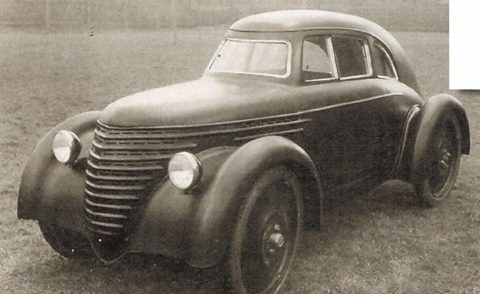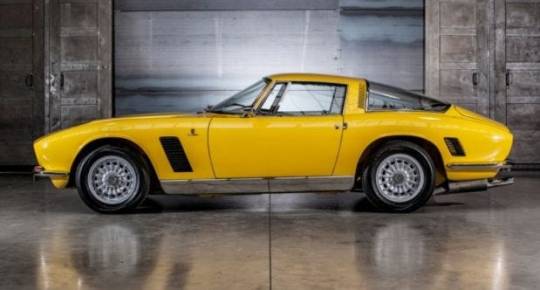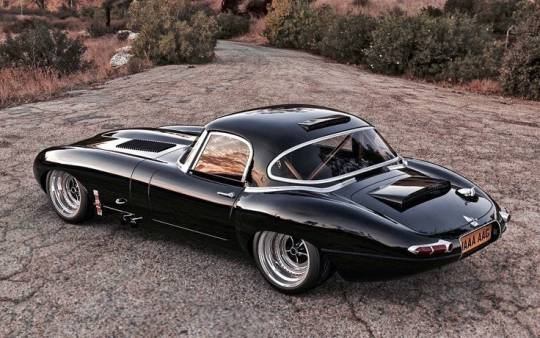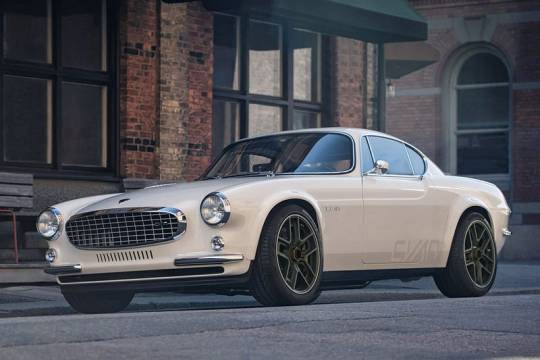Don't wanna be here? Send us removal request.
Text
1929 Avions Voisin C14

The Avions Voisin C14 was a luxury car produced by the French manufacturer Avions Voisin in the late 1920s. It was part of the Voisin C-series, which included a range of high-end vehicles known for their distinctive and avant-garde designs.
The C14 was introduced in 1927 and featured many of the characteristics that made Voisin cars stand out. It had a unique and aerodynamic body design, which was the result of collaboration between Gabriel Voisin, the company’s founder, and the automobile designer André Noël Noelte. The bodywork was often handcrafted and tailored to the individual customer’s specifications.
The C14 was built on a sturdy chassis and featured advanced engineering for its time. It was powered by an inline-six engine, which had a displacement of 3.3 liters and produced around 80 horsepower. This provided the car with respectable performance and a top speed of approximately 75 mph (120 km/h). The engine was mated to a four-speed manual transmission.
One of the notable features of the Avions Voisin C14 was its suspension system. It utilized a unique sliding pillar front suspension, which provided a comfortable ride and excellent road handling. The car also boasted hydraulic brakes, which were still a relatively new technology at the time.
The interior of the C14 was luxurious and well-appointed, featuring high-quality materials and attention to detail. The dashboard had a distinctive layout with centrally positioned instrumentation, and the seating offered comfort and support for the occupants.
Despite its advanced engineering and luxurious features, the Avions Voisin C14 was produced in limited numbers, and its high price tag made it exclusive to wealthy customers. The economic difficulties of the late 1920s and early 1930s also contributed to the challenges faced by Avions Voisin, and the company went bankrupt in 1939.
Today, the Avions Voisin C14 is considered a rare and highly collectible automobile. Its distinctive design, advanced engineering, and association with the Art Deco era make it an object of fascination for automotive enthusiasts and collectors.
If you are interested you should read about Porsche First Car
#cars#classic car#classic cars#vintage cars#vintage#fast cars#cars of japan#car show#cars and girls#car seat headrest#luxury cars#muscle cars#electric cars
0 notes
Text
1938 Framo-Goritz Streamliner

The 1938 Framo-Goritz Streamliner, also known as the Framo Stromlinienwagen, was an experimental car built in Germany in the late 1930s. It was designed by aircraft engineer Paul Jaray and built by the Framo company, which was known for producing commercial vehicles.
The Streamliner featured an aerodynamic design with a teardrop-shaped body, which was quite unusual for that era. It had a streamlined front end with a sloping windshield, smooth curves, and a tapered tail. The car's body was made of lightweight materials such as aluminum to reduce weight and improve fuel efficiency.
Under the hood, the Framo-Goritz Streamliner was powered by a rear-mounted two-stroke engine. The exact specifications of the engine are not readily available, but it was likely a small-capacity unit designed for economy rather than performance.
The car was intended to be highly fuel-efficient and aimed at breaking long-distance records. It reportedly achieved impressive fuel economy figures, with some sources claiming it could achieve up to 90 miles per gallon (38 kilometers per liter) at a speed of around 45 mph (72 km/h).
The Framo-Goritz Streamliner was showcased at the Berlin Motor Show in 1939, where it garnered considerable attention for its futuristic design and fuel efficiency. However, due to the outbreak of World War II and the subsequent focus on military production, the Streamliner never entered mass production, and only a single prototype was built.
Today, the surviving prototype of the 1938 Framo-Goritz Streamliner is considered a rare and historically significant vehicle. It serves as a fascinating example of automotive aerodynamics and engineering innovation from the pre-war era.
If you are interested you should read about Top 10 Porsche Cars for Collectors
#cars#classic cars#luxury cars#vintage cars#car show#cars of japan#car seat headrest#muscle cars#cars and girls#vintage
0 notes
Text
Porsche 918 Spyder

The Porsche 918 Spyder isn’t just a car; it’s a symphony of innovation and speed that redefines the realm of hypercars. Its sleek design, coupled with exceptional engineering, sets it apart in a league of its own.
Unveiling Porsche’s Iconic Hybrid Innovation
This section delves into the groundbreaking hybrid technology that propels the Porsche 918 Spyder to remarkable heights. The integration of electric motors alongside a high-revving V8 engine showcases Porsche’s commitment to pushing the boundaries of automotive engineering.
From the Instant Torque of Electric Motors to the V8 Symphony
Crafted to perfection, the fusion of electric motors and the roar of the V8 engine in the Porsche 918 Spyder delivers an unparalleled driving experience. Feel the instant surge of torque as the electric motors seamlessly complement the visceral growl of the high-performance engine.
The 918 Spyder: Performance Redefined
Buckle up for an exhilarating ride through the performance metrics that make the Porsche 918 Spyder a force to reckon with on the tracks and streets alike.
Speed Unleashed
The 918 Spyder blazes from 0 to 60 mph in a jaw-dropping sprint, achieving this feat in mere seconds. Its top speed? A mind-bending figure that leaves competitors in the dust.
Handling Precision
Experience automotive precision at its finest. The 918 Spyder’s handling is as responsive as it is refined, making every curve an opportunity to showcase its agility.
Exquisite Design: Aesthetic Harmony and Aerodynamic Mastery
Porsche marries form and function seamlessly in the design of the 918 Spyder. Its aerodynamic silhouette doesn’t just turn heads; it enhances performance.
Porsche 918 Spyder: An Enthusiast’s Dream
The allure of the 918 Spyder extends beyond its speed and technology. Enthusiasts and collectors cherish its limited production and exclusivity.
FAQs
What makes the Porsche 918 Spyder stand out from other supercars? The 918 Spyder’s hybrid technology, combining electric motors with a high-performance engine, sets it apart, delivering exceptional speed and efficiency.
How fast can the Porsche 918 Spyder go? The 918 Spyder boasts a top speed exceeding 210 mph, showcasing its incredible performance capabilities.
Is the Porsche 918 Spyder a limited edition model? Absolutely! Porsche limited the production of this marvel, adding to its desirability and exclusivity.
How does the hybrid technology in the 918 Spyder work? The hybrid system seamlessly integrates electric motors and a combustion engine, offering instant torque and enhanced efficiency.
What makes the design of the 918 Spyder unique? Porsche’s design combines aesthetics with aerodynamics, ensuring a striking appearance while optimizing performance.
Is the 918 Spyder suitable for everyday driving? Despite its track prowess, the 918 Spyder offers comfort and drivability for everyday use, making it a versatile supercar.
If you are interested you should read about Top 10 Porsche Cars for Collectors
#porsche#cars#cars of japan#classic cars#fast cars#cars and girls#luxury cars#politics#electric cars#muscle cars#car show#car seat headrest
1 note
·
View note
Text
Iso Grifo

The Iso Grifo is a high-performance grand tourer produced by the Italian manufacturer Iso Autoveicoli S.p.A. from 1965 to 1974. It was designed by Giorgetto Giugiaro, who was working at Bertone at the time. The Iso Grifo combined Italian styling with American power, featuring a blend of European design and American V8 performance.
The Grifo was available in different variants, including a coupe and a convertible. Its design was characterized by clean lines, a low-slung profile, and aggressive yet elegant styling cues. The bodywork was crafted from steel and featured aluminum doors, hood, and trunk lid for weight reduction.
Under the hood, the Iso Grifo was powered by various engines throughout its production. Initially, it was offered with Chevrolet small-block V8 engines, including the 5.4-liter and 7.0-liter variants. Later models featured Ford’s 7.0-liter V8 engine. These powerful engines delivered impressive performance, with acceleration and top speeds that matched or exceeded other high-performance cars of the era.
The interior of the Iso Grifo was luxurious and well-appointed, featuring high-quality materials, comfortable seating, and a range of amenities. It offered a combination of sportiness and elegance, with a driver-focused cockpit and ample space for occupants.
The Iso Grifo gained a reputation for its exceptional performance, refined handling, and comfortable ride, making it a capable grand tourer for long-distance driving. It was also appreciated for its exclusivity, as production numbers were relatively low compared to other sports cars of the time.
If you are interested you should read about BMW 507
#cars#cars of japan#classic cars#fast cars#electric cars#muscle cars#cars and girls#car seat headrest#car show#luxury cars
1 note
·
View note
Text
Jaguar E-Type

The Jaguar E-Type, also known as the Jaguar XK-E in the United States, is a classic sports car that was produced by Jaguar Cars from 1961 to 1975. It is widely regarded as one of the most beautiful and iconic sports cars ever created.
Introduced at the Geneva Motor Show in 1961, the E-Type made an immediate impact with its sleek and aerodynamic design, which was influenced by the Jaguar D-Type racing car. It featured long, flowing lines, a low-slung body, and a distinctive oval-shaped front grille. The E-Type’s design was the work of Jaguar’s chief designer, Malcolm Sayer.
The E-Type was offered in different body styles, including a two-seater coupe (known as the Fixed Head Coupe, or FHC), a two-seater convertible (Open Two-Seater, or OTS), and a 2+2 coupe with a slightly longer wheelbase. The interior of the E-Type was luxurious and featured leather upholstery, wood trim, and a well-designed dashboard with a range of instruments.
Under the hood, the E-Type initially featured a 3.8-liter inline-six engine that produced impressive performance for its time. Later models were equipped with a 4.2-liter inline-six engine. The E-Type was known for its excellent acceleration and top speed, making it one of the fastest cars of its era.
In 1971, the E-Type underwent a significant redesign, resulting in the Series 3 model. This version featured a larger and more powerful 5.3-liter V12 engine, as well as other updates to the exterior and interior design.
The Jaguar E-Type is highly regarded for its combination of stunning looks, exhilarating performance, and accessible price compared to other sports cars of its caliber. It remains an automotive icon and a sought-after collectible among classic car enthusiasts.
If you are interested you should read about the Top 10 Porsche Cars for Collectors
2 notes
·
View notes
Text
Rolls Royce silver cloud

The Rolls-Royce Silver Cloud is a classic luxury car produced by Rolls-Royce Limited from 1955 to 1966. It was the successor to the Silver Dawn and was available in different variants, including a four-door saloon, two-door coupé, and a convertible.
The Silver Cloud was known for its elegant and timeless design, luxurious interior, and smooth ride quality. It featured a powerful engine and advanced suspension technology for its time, providing a comfortable and refined driving experience.
The Silver Cloud was often handcrafted and customizable, allowing buyers to choose from a range of options and features to suit their preferences. The interior was opulently designed with high-quality materials, fine wood veneers, and sumptuous leather upholstery.
In terms of performance, the Silver Cloud was powered by a variety of engines throughout its production, including inline-six and V8 engines. The most notable variant was the Silver Cloud II, introduced in 1959, which featured a more powerful V8 engine and improved performance.
The Rolls-Royce Silver Cloud has become an icon of luxury and elegance, and it remains highly regarded among collectors and enthusiasts of classic cars. It represents the craftsmanship and attention to detail that Rolls-Royce is known for.
If You are interested you should read about the Top 10 Porsche Cars for Collectors
#rolls royce#car seat headrest#car show#cars#cars and girls#cars of japan#electric cars#classic cars#fast cars#luxury cars#rambles
1 note
·
View note
Text
Ferrari 275 GTB

The Ferrari 275 GTB is a classic sports car produced by the Italian automaker Ferrari from 1964 to 1968. It is considered one of the most iconic and desirable models in Ferrari’s history, known for its elegant design, performance capabilities, and racing pedigree.
Here are some key features and details about the Ferrari 275 GTB:
1. Design: The 275 GTB was designed by Pininfarina, the renowned Italian design house. It featured a graceful and timeless design with smooth lines, a long bonnet, and a short rear end. The overall shape was aerodynamically efficient and visually striking.
2. Engine: The 275 GTB was powered by a 3.3-liter Colombo V12 engine. Depending on the model, it produced around 260 to 280 horsepower. The engine was mounted in the front and provided exhilarating performance.
3. Transmission: The 275 GTB came with a 5-speed manual transmission, which allowed drivers to fully engage with the car’s power and performance.
4. Performance: The performance of the 275 GTB was impressive for its time. It had a top speed of around 160 mph (260 km/h) and could accelerate from 0 to 60 mph (0 to 97 km/h) in approximately 6 seconds.
5. Racing Success: The 275 GTB had a successful racing career. It competed in various races, including the 24 Hours of Le Mans, where it achieved class victories. The 275 GTB’s racing pedigree further added to its desirability and reputation.
6. Variants: The Ferrari 275 GTB was available in different variants, including the standard GTB, the GTB/4 (also known as the 275 GTB/4), and the lightweight Competizione Speciale models. The GTB/4 was notable for being the first road-going Ferrari to feature a four-cam V12 engine.
7. Limited Production: Approximately 800 units of the 275 GTB were produced across all variants, making it a relatively exclusive and sought-after model among collectors.
If you are interested you should read about BMW i3
#ferrari#ferrari f1#forza ferrari#formula1#scuderia ferrari#motorsport#luxury cars#fast cars#cars of japan#classic cars#muscle cars#cars#car show#cars and girls
2 notes
·
View notes
Text
1964 Volvo P1800

The 1964 Volvo P1800 is a classic car model produced by Volvo Cars from 1961 to 1973. It is a two-door sports car that gained popularity for its stylish design and reliability. The P1800 is often considered one of Volvo’s most iconic and beloved models.
Here are some key features and details about the 1964 Volvo P1800:
1. Design: The P1800 was designed by Pelle Petterson and inspired by Italian coachbuilder Frua’s prototype. It features a sleek and elegant design with flowing lines, a long hood, and a short rear end. The design was well-received and has stood the test of time, maintaining its classic appeal.
2. Engine: The 1964 P1800 was powered by a 1.8-liter B18 inline-four engine. It produced around 100 horsepower, providing a decent level of performance for its time.
3. Performance: The P1800 offered a balance between sportiness and comfort. It had respectable performance for its era, with a top speed of around 109 mph (175 km/h) and a 0–60 mph (0–97 km/h) acceleration time of approximately 11 seconds.
4. Reliability: Volvo’s reputation for safety and durability extended to the P1800. The car was known for its robust build quality and reliability, which contributed to its long-lasting popularity among enthusiasts.
5. Pop Culture Status: The Volvo P1800 gained significant recognition after being featured in the television series “The Saint” (1962–1969) starring Roger Moore as Simon Templar. The car became closely associated with the character and further elevated its status and desirability.
6. Production: Over the course of its production years, Volvo produced around 47,000 P1800 units. The 1964 model year was part of the early production years for the P1800.
If you are interested you should read about BMW F10
#car seat headrest#volvo#volvo 240#volvo cars#classic cars#cars of japan#cars and girls#luxury cars#fast cars#muscle cars#volvo trucks#how abandoned volvo appeared on tiny remote island surrounded by 38ft deep lake…which can even be seen on google maps#cadillac#toyota#cars#electric cars
4 notes
·
View notes
Text
lamborghini countach

The Lamborghini Countach is an iconic and legendary supercar produced by the Italian automaker Lamborghini from 1974 to 1990. It is considered one of the most recognizable and influential sports cars of all time and has become a symbol of automotive design and performance.
Here are some key features and details about the Lamborghini Countach:
1. Design: The Countach’s design is often described as futuristic and radical. It was penned by Marcello Gandini of the Bertone design studio, and its sharp angles, scissor doors, and low, wedge-shaped profile make it instantly recognizable. The Countach’s design pushed the boundaries of automotive styling and became a symbol of the 1980s.
2. Performance: The Countach was known for its impressive performance capabilities. It featured a mid-mounted engine configuration, usually a powerful V12 engine, which delivered exhilarating acceleration and top speeds. Over the years, the Countach evolved with various engine options and power outputs, with some versions exceeding 450 horsepower.
3. Top Speed: The top speed of the Countach varied depending on the model and engine configuration. The later models, such as the Countach 5000 QV (Quattrovalvole), could reach speeds of over 180 mph (290 km/h).
4. Interior: The Countach’s interior was focused on the driver and had a minimalist design. The cockpit was designed to provide an engaging driving experience, with a low seating position and a high center console that housed various controls and switches. However, the interior was known for its tight and cramped cabin space, making it challenging for taller individuals.
5. Pop Culture Status: The Countach gained significant exposure and became an automotive icon through its appearances in popular culture, including movies, music videos, and posters. Its striking design and association with luxury and performance made it a symbol of status and aspiration.
6. Limited Production: The Countach had a limited production run, with approximately 2,000 units produced over its production years. This exclusivity, combined with its iconic design and performance, has made it highly sought-after by collectors and enthusiasts.
The Lamborghini Countach remains a legendary and influential supercar, representing the bold and uncompromising spirit of Lamborghini. Its striking design, powerful performance, and cultural significance have firmly established it as one of the most iconic cars in automotive history.
If you are interested you should read about the 13 Best Cars to Buy under $10k
#car seat headrest#cars#cars of japan#cars and girls#fast cars#luxury cars#classic cars#lamborghini#supercars#hypercars#italian cars
0 notes
Text
bmw e9 3.0 csi

The BMW E9 3.0 CSi is a classic car model produced by BMW from 1971 to 1975. It was part of the New Six series and is highly regarded among BMW enthusiasts for its design and performance.
Here are some key features and details about the BMW E9 3.0 CSi:
1. Engine: The 3.0 CSi was powered by a 3.0-liter inline-six engine, which was an upgraded version of the earlier 2800 CS model. It featured Bosch fuel injection and produced around 200 horsepower, making it a powerful car for its time.
2. Performance: The 3.0 CSi had impressive performance capabilities. It could accelerate from 0 to 60 mph (0 to 97 km/h) in around 7 seconds and had a top speed of approximately 135 mph (217 km/h).
3. Design: The E9 3.0 CSi featured a sleek and elegant design, which was typical of BMW’s “New Class” era. It had a long, low-slung body with a distinctive shark-nose front end and a Hofmeister kink at the rear pillar, which became a signature BMW design element.
4. Interior: The interior of the 3.0 CSi was luxurious and well-appointed. It featured comfortable seating for four occupants and a range of premium materials, including wood trim and high-quality upholstery.
5. Limited Production: The 3.0 CSi was a relatively rare car, with a limited production run. Approximately 8,000 units were built during its production years, making it a sought-after collector’s item today.
6. Motorsport Success: The 3.0 CSi also had success in motorsport, particularly in the European Touring Car Championship. It was a competitive race car and achieved several victories and podium finishes during its racing career.
If you’re interested you should read about the 13 Best Cars to Buy under $10k
#bmw#cars#cars of japan#classic cars#luxury cars#bmw cars#bmwedit#bmw m3#bmw driver#automotive#classic car#fast cars
5 notes
·
View notes